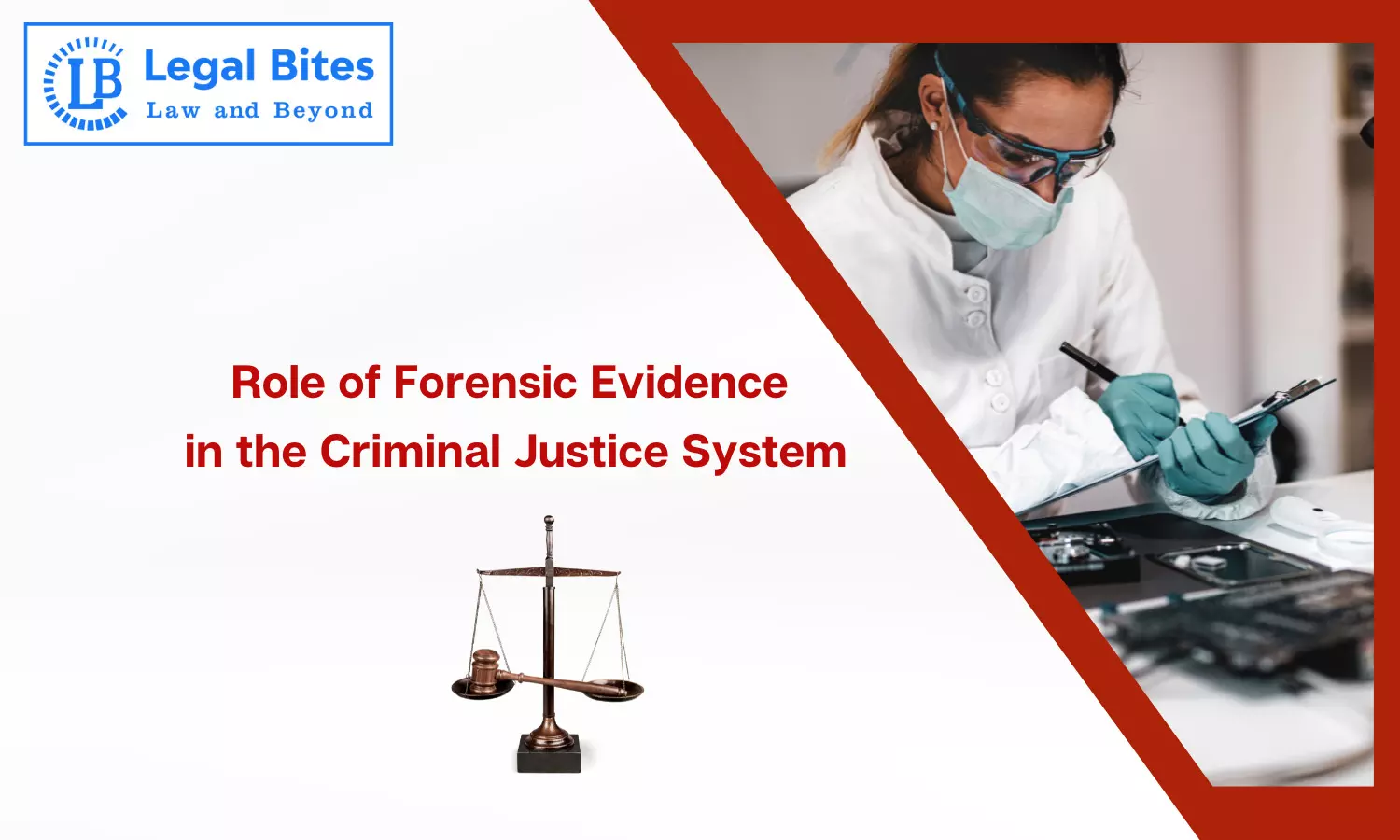Role of Forensic Evidence in the Criminal Justice System
The article 'Role of Forensic Evidence in the Criminal Justice System' intends to explore the facets of forensic sciences and their crucial contribution towards the criminal justice system.

The article 'Role of Forensic Evidence in the Criminal Justice System' intends to explore the facets of forensic sciences and their crucial contribution towards the criminal justice system.
The use of science in legal procedures has gained momentum in the last few decades. The study of significant evidence presented in court proceedings can assist in proving the guilt or innocence of potential suspects. These examinations are often carried out using scientific, medical, or technological methods. These tried-and-true methods can be utilized to establish the circumstantial facts under investigation as well as to back up and validate legal assertions.
Introduction: Forensic Evidence
In the middle of the 19th century, Natural Science started to advance rapidly. As scientific experiments steadily shed new light on the mysteries of the world, the mystic explanations previously presented to explain the order of things started to lose popularity. Not just in criminal investigations but also in the other parts of the legal system, the shift in perspective from the mystic to the scientific was rapidly obvious. A single case had now taken on two sides. The facet stated and the facet proved from a scientific viewpoint.
Although professionals from a variety of disciplines currently contribute to extensive forensic work in regard to family, immigration, and criminal law, any given discipline could theoretically be referred to as "forensic," forensic evidence was originally provided by forensic scientists. Forensic Professionals testify as expert witnesses, recruited by either the prosecution or defense.
In terms of the etymology of the word, ‘forensics’ (derived from the Latin word, ‘forensis’), and when extracted from the phrase, ‘science’, its origins are firmly rooted in discussions or examinations performed in public. Where results were more widely accountable and strong judicial connotations began, in general, the best way to define forensics is as the utilization of different related approaches and processes to solve crimes.
Role of Forensic Evidence in the Criminal Justice System
A crucial component of the criminal justice system is forensic science. Its primary focus is on the examination of physical and scientific hints found at crime scenes. The distinctiveness of the crime's perpetrator is discussed in forensic science. The nature (what) of the offence is unambiguously defined by the evidence. Forensic evidence identifies the crime scene and the location of the crime. A government agency like the police, CID, CBI, etc. that enforces civil and criminal laws uses forensic science to do so. Applying scientific methodology and knowledge to legal challenges is the main focus of forensic science.
The role of forensic science in the justice and legal systems is well acknowledged in the prosecution of criminals for evidence. This is due to the fact that when scientific procedures and techniques are employed, there is little room for injustice and bias. Forensic Science is a part of the law that aids in evaluating many features such as DNA, fingerprints, blood samples, chemical and toxin tests, and so on in a trial and investigation of a case. Forensic evidence is also utilized to connect crimes that are suspected to be related.
Classification of Forensic Evidence
Forensic evidence can take countless forms in areas which might surprise many people. Apart from the more prominent and well-known topics associated with medicine and science, expert forensic witnesses can easily have a wealth of expertise and knowledge in more interdisciplinary areas.
Forensic evidence is classified into various kinds, based on the variety of evidence such as fingerprints, hair, blood, semen, fibre, firearms, drugs, etc. collected at the crime scene. They are classified into:
1) Biological Evidence: Blood (wet blood or swabs of bloodstains) and saliva are the most common types of biological evidence. Others include seminal stains, urine, perspiration etc.
2) Weapons Evidence: It consists of firearms such as handguns, revolvers, rifles, assault weapons, etc.; ammunitions including used casings, fired projectiles, fragments of bullet, and unfired bullets; gunshot residue and blades including knives.
3) Generic Objects: It includes door, wood, bicycle and concrete.
4) Electronic/Printed Data: Electronic and printed data include documents and electronics (computers, cell phones, etc.).
5) Fingerprint Evidence: It consists of fingerprints of both hands of the accused or the victim and includes latent and patent fingerprints as evidence.
6) Trace Evidence: Evidence which is very small in quantity is called trace evidence which covers evidence such as fibres, hair, asbestos, cigarettes, tobacco, glass etc.
7) Natural Materials: It includes clothes, beds, bathing material, carpet cuttings, metal objects, plastic, paper etc.
8) Drug Evidence: It includes drugs like marijuana, cocaine, methamphetamine and others along with drug paraphernalia ie. pipes, spoons etc as accessories, found at the scene of the offence.
9) Impressions: It means an impression made by material on a substance and includes shoeprint impressions, tyre tracks, tool marks etc.
10) Other Items: Evidence which does not fall into any of the above-mentioned categories is referred to as other items.
Fundamental Principles of Forensic Science
In the identification and investigation of crimes, forensic evidence is crucial. However, the scientific evidence that the criminal justice system relies on is founded on a number of reliable principles, making it pertinent and admissible in court. The following are a few principles which add value to the role of forensics in the legal system:
1) Principles of Analysis: For effective use of scientific evidence in trials, emphasis is to be laid on correct sampling and packaging procedures.
2) Principles of Comparison: Only those things which are similar in nature can be compared. This principle stresses the need of providing similar samples or specimens for the purpose of comparison.
3) Individuality: Every object, natural in nature has an individuality. Neither nature duplicates it nor the man. For example- fingerprints.
4) Law of Progressive change: Change in everything takes place with the passage of time. The crime scene, physical evidence, and criminal involvement in the crime undergo change as time passes by.
5) Locard’s Principal: Whenever two identities come in contact, there is an exchange of traces mutually. This is known as Locard’s exchange principle.
6) Law of Probability: It determines the change of occurrence of a particular event in a particular way out of a number of ways in which the event can take place or fail to take place with equal facility
When scientific evidence is obtained and assessed, police officers (investigating officers) are often around three times more likely to resolve cases. If the forensic evidence strongly links the accused person to the commission of the crime, prosecutors could not agree to initiate discussions. We may therefore evaluate the necessity and significance of forensic evidence in our legal system by using it at various levels of inquiry and trial.
Admissibility of Forensic Evidence in the Courts
The Indian Evidence Act, 1872 addresses the applicability of an expert's opinion in a case under Sections 45 to Section 51. According to the Act, a witness may only testify for facts that they are directly aware of. However, compared to the norm, these provisions are extraordinary. It is founded on the idea that without aid from someone with specialised expertise and understanding of the subject, the court cannot make an opinion or reach a decision on a subject that is technically complex and sophisticated.
An "Expert" is a person with specialised knowledge and abilities in the relevant field. Experts in medicine, chemistry, explosives, ballistics, and fingerprint analysis are a few examples of forensic professionals.
However, there are two requirements that must be met for the courts to accept an expert's testimony:
- That the issue at hand cannot be resolved without the expert's view; and
- That the witness is qualified to use the title of expert.
When it comes to the admission of expert testimony, the legal systems around the world encounter numerous difficulties. The judges are not expected to generate an independent conclusion on scientific subjects, particularly the social sciences, involving complicated quantitative and qualitative evaluations because they typically lack specialized scientific understanding. Because of this, the courts consult with specialists who, as a result of their education or experience, can offer justifications that can be taken into account when making decisions.
Fyre and Daubert's Case
Frye v. US, 293 F. 1013 0.C. Cir. 1923
Due to the polygraph's lack of widespread acceptance at the time of this case, the Columbia court dismissed its legitimacy. Guidelines for the admissibility of experimental examination procedures were established by the court. Only when a court can demonstrate that a substantial section of the pertinent scientific community has supported this approach, may the Frye Test be used. When the Federal Rules of Evidence were adopted by the federal courts in 1975, this Frye Test underwent still another modification. As a result, there was flexibility and no rigid acceptance.
Daubert v. Merrell Dow Pharmaceuticals Inc, 509 U.S. 579 (1993)
In the case, the court outlined how the Federal Rule takes into account both widespread acceptability and science. The Daubert Court stated that robust cross-examination and scrutiny of the offered evidence can establish the veracity of forensic science evidence that they are unsure of. While many states now adhere to the Daubert requirements, only a few still adhere to the federal regulations.
Important Case Laws
1. Susheel Mandal v. State, HCP.No.801/2014
The Petitioner who had contested the DNA results, in this case, was the father of a deceased boy. The deceased youngster died just as he and a schoolgirl were beginning to develop romantic feelings for one another. One day the youngster was reported missing, and a week later a completely decayed and hence unrecognizably dead body was discovered in a lake. The body was not recognised by the petitioner, and neither were the garments necessary to prove that the man was his own son. In a habeas corpus petition, he claimed to be the girl's father and asked the High Court to order the Central Bureau of Inquiry (CBI) to conduct the inquiry. Post conduct of the DNA Test, the deceased person’s DNA matched with the petitioner and his wife. The apex court relied on the scientific tests that were conducted and hence the matter got closed.
2. Magan Bihari Lal v. State of Punjab, 1977 AIR 1091
It is a well-known case where the Supreme Court overturned the conviction based on the experts' identification of the handwriting. The Supreme Court ruled that one should proceed cautiously when considering an expert's advice.
Conclusion
Using Forensic Science to gather evidence is primarily important for ensuring that justice is done fairly. This is done so that the guilty party, not the innocent one, should be punished for the actual offence. In numerous instances, forensic evidence has been useful in locating the true offender, who is then punished by the court. More valuable than other court-produced evidence is forensic evidence.
Nevertheless, there are occasionally—and very infrequently—some defects in the evidence. More specialists should be honoured since they consistently provide knowledge and pertinent evidence about the issue, which enables the case to be resolved on that foundation. By expanding forensic science, the nation can see more growth. This could establish rigid guidelines for punishing the accused.
References
[1] Uzma Naaz, Forensic Evidence Relevancy in Crime Scene, Available Here
[2] Preeti Pallavi Jena, Admissibility of forensic evidence, Available Here
[3] Sambreeta Dabral, Forensic Evidence in Criminal Justice System in the Light of Daubert Standards, Available Here
[4] Lakshmi Prasanna Bolem, Forensic Evidence: Types and its Admissibility, Available Here
Important Links

